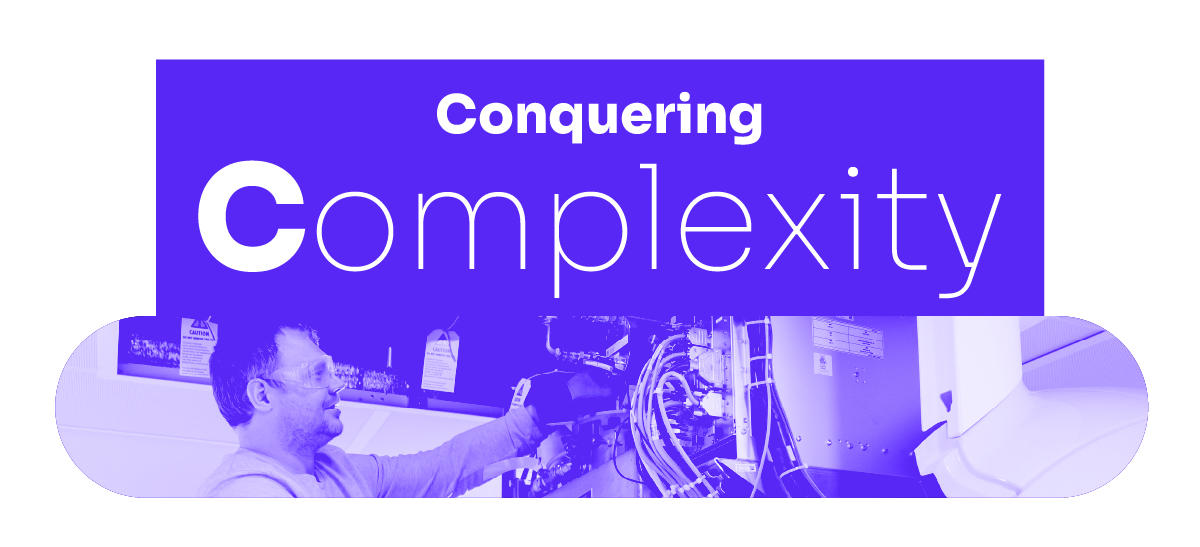How to Give Your People the Tools, Training and Tactics to Maximize Efficiency and Grow Business
You’re looking for ways to make your medical device service organization more efficient.
You’re fully prepared to embrace innovation and champion digital transformation.
But you don’t know where to begin.
That’s why we suggest that you focus on your people.
Your company trusts its field service engineers on the front lines. And every day you send them out to face challenges from customers and competitors.
It’s not easy out there. They need all the help you can give.
The job is complex, requiring a wide range of skills and knowledge to properly install, maintain, and repair medical devices. But they deal with much more than just nuts and bolts and vacuum drift tubes and x-ray collimators.
If you want your teams to over deliver on service expectations and help grow your business, you need to give them more than just a tool box and a truck.
We’ve compiled some tips and tactics for helping your service organization master the three C’s of medical device field service: complexity, compliance, and communication.

Conquer Complexity
Keep pace with changing technology by making learning a habit, connecting with peers and leveraging your secret weapon
If you grew up working on cars, you remember back when a simple set of socket wrenches was all you needed to get a conked-out ride back on the road.
These days, what sits under the hood of cars looks more like a supercomputer. It’s too advanced for most weekend mechanics, so they leave the sockets on the shelf and send their car to the experts.
Your field engineers don’t have that luxury. They have to be THE experts.
“75% of field technicians report that products have become more complex and more knowledge, specifically more technical knowledge, is needed to perform their jobs now vs. when they started in field service” – The Service Council, 2021
Here’s the challenge: Medical devices are already highly complex, with intricate mechanisms and systems that require specialized knowledge and expertise to understand. And that technology is advancing every day.
Even more challenging? Medical device field engineers need a strong foundation in both the technical AND clinical aspects of devices. Not only do they need to understand how the devices function, but how they’re used in the healthcare setting.
That hulking MRI machine may look stationary, but every job callout for med device field engineers requires them to hit a moving target. Not only is the science behind those advanced machines constantly evolving, but the way hospitals and healthcare systems function is ever changing too.
That’s why education and training is never a “one and done” kind of deal. Service teams need to make learning a daily habit.
Here are tips for keeping your team up to speed:
- Connect with a Community
Industry conferences and trade shows are great opportunities to learn about the latest developments in the medical device industry and network with other professionals. If your sales and marketing teams regularly attend events, consider adding technical employees into the mix.Also encourage them to seek out med device resources online in the form of trade publications, video channels and podcasts. The internet is an all-you-can-eat buffet of relevant and increasingly niche information.
- Train for Tomorrow
Why not give your service team a head start on what comes next? In addition to helping them master your current machines, look for opportunities to educate them on future medical technology.Med devices are evolving at a record pace thanks to advances in AI and machine learning, as well as nanomaterials and 3D printing. The future is no longer some imaginary place in the distance.BIG changes are coming in the next 5-10 years. Help them get ready.
- Leverage Internal Knowledge
Every company has treasure troves of technical, industry and practical knowledge buried inside the heads of its people. Do yourself a favor and find ways to get it all out into the open.
Protect yourself against “Great Resignations” and the “Gray Tsunami” by capturing the wisdom of your veteran technicians BEFORE they head out the door. You can immediately use that institutional knowledge to get new hires up to speed much faster.
How? Create a system for interviewing and collecting information from your most experienced and valuable employees. Build a text or video library. Schedule your own “Ask an Expert” sessions.
Or you could always tap into that valuable resource in real-time using a software platform that allows junior field techs who are on-site to connect remotely with experienced pros for real-time guidance.
“Using remote support technology has improved on-the-job training and decreased the time to train new technicians by an average of 41%” – SightCall

Uncomplicate Compliance
Cut down on penalties and fines by building systems, automating processes and making it harder to make expensive mistakes
You already work on incredibly complex machines that save human lives. You are already asked to perform repairs under near impossible deadlines.
Why not add a few layers of wildly complicated government guidelines and ever-changing federal and international regulations?
Medical device service is nothing if not challenging.
The machines you manufacture and service are subject to a range of regulations and guidelines, including those set by the Food and Drug Administration (FDA) and international standards organizations like the International Electrotechnical Commission (IEC).
These rules vary by country, change frequently and stepping “out of bounds” can result in serious fines and penalties.
The bottom line? Breaking the rules is bad for your bottom line.
Here are a few suggestions for helping your field techs master the fine art of compliance:
Set the Tone in TrainingGive your on-site engineers everything they need to know about compliance before they head into the field. Minimize costly errors by helping them understand the business impact of non-compliance.
Design Systems for SuccessReduce careless tracking and documenting mistakes by setting up consistent systems. Implement policies and procedures for servicing medical devices correctly and in compliance with relevant regulations. Make sure you have a quality management system (QMS) in place to help ensure that medical devices are serviced to the highest standards of quality and safety.
Automate to Reduce RiskTake a closer look at how service teams handle compliance information. Proper documentation and record-keeping practices are essential. This includes keeping accurate and up-to-date records of all service activities, as well as maintaining records on the performance and maintenance of medical devices.Does any of your compliance documentation process still include the use of pen and paper? Then you are exponentially increasing the risk of human error.One way you can lower that risk is with automated digital work instructions that eliminate the possibility of lost paperwork, sloppy handwriting or skipped forms.
“Businesses lose an average of $11,000 per employee every year due to ineffective communications and collaboration” – Mitel, 2017

Champion Communication
Untangle crossed wires by creating clear channels that connect and empower your employees
You rely on teams to solve problems and resolve issues. And teams require collaboration and coordination.
But communication is the real glue that holds everything together.
If you want to improve the efficiency of your service teams, here are some key communication questions to consider:
- How do you rate your “pre-call clarity”?
Improving communication starts with the first service request. The better your team can set and manage expectations, the better. Understand exactly what’s happening with the device on site before rolling a truck to ensure you arrive prepared.
The more insight you get up front, the faster you can resolve the issue. You can use a number of different tools to improve clarity, but we’re (understandably) partial to a visual platform that can capture media, scan data, and give you eyes on site. - Are you optimizing the way that on-site employees communicate with other service team members and supervisors?
If you’re relying on smartphones and text messages, you need to make sure that vital information isn’t falling through the cracks. When the messages include questions and details about real-time issues, what happens if one side doesn’t respond? What if verbal instructions aren’t clear or signal quality is poor?
Setting up robust and reliable communication channels saves time. And the more information that can be exchanged through those channels, the better. Pictures are always better than words and video is best of all. - If technicians get stumped on site, do they power through and hope for the best? Or are they empowered to reach out for guidance?
Having a way to connect more than one employee in many different places helps amplify the effectiveness of your team.
Instead of “one tech, one truck,” remote support tools give you the power to instantly deploy teams of experts when and where they are needed. Two heads are always better than one, even if one of those heads is virtual. - Do you provide communication training in “medium skills”?
Odds are good that “medium skills” isn’t really a thing.
But for now, let’s pretend they fall between “soft skills” like communication, problem solving and teamwork and the much more technical “hard skills.” “Medium skills” can be things like sales techniques, interviewing, and light detective work.
Most field engineer employment ads already start with outlining requirements like “outgoing, energetic and good with people.”
That’s because field service engineers act as the face of your company on every single call.
That’s both a big responsibility and a huge opportunity. Don’t miss the chance to make sure that every employee understands the value of face-to-face customer time.
Get the job done right. Get the job done fast. But don’t stop there.Encourage your field team members to be proactive and inquisitive. Great smiles go a long way, but the ability to collect actionable insights is even better.
Yes, “collecting actionable insights” sounds a bit nefarious, but the ultimate goal is to HELP your customer.
Gaining insight helps you understand your customer’s “big picture” and recurring pains. Only then can you find new and better ways to delight them, anticipate their needs and make their business lives better.

Transformation is a journey, not a destination
Healthcare technology is in a constant state of change. Brilliant minds are stretching the boundaries of what’s possible. And nobody knows for sure what the future holds for medical science.
Chips are getting smaller. Computers are getting smarter.
But people still matter more than ever.
Focus on your people.
There are no one-size-fits-all solutions for building a more efficient service organization. But if you’re looking for growth, we humbly suggest that you invest in your greatest asset.
Help them master the three C’s, and give them the tools and technology they need to get better at what they do.




